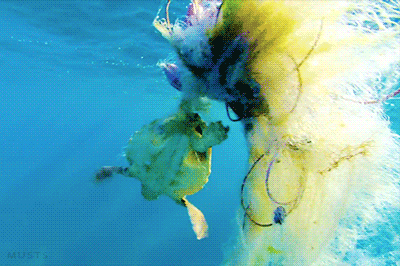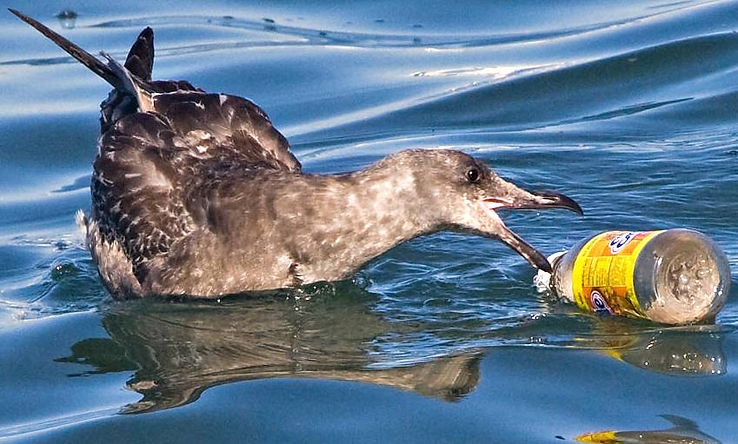
Impact on Ocean Life
By 2050 our oceans will hold more plastics than fish if we do not find a solution now.



Industrial Pollutants Impacts
Once in the water, the more highly processed industrial chemicals are substantially diluted. But this does make them go away. Our understanding of the impact of low concentrations of these pollutants is poor, but it is hard to see how it isn’t harmful. It is generally suspected that they interrupt the natural functioning of reproductive, immune and endocrine systems of marine animals, though studying these in the open ocean difficult due to its size.
When these pollutants become concentrated, the evidence is clearer. There are multiple ways that a dispersed pollutant becomes concentrated again once it is in the ocean. One example is concentration through the food chain. Mercury, a trace metal used in many industrial and consumer applications is present in low levels and absorbed by algae, then by small fish, then by larger fish that eat the smaller fish, then eventually by top level feeders like swordfish and tuna that make their way into restaurants. If we think that pollution does not affect each of us as well as marine life and animals, we would do well to review the FDA’s recommendation on moderating our intake of tuna, which is mainly targeted at the dangers of Mercury consumption in humans. The world is interrelated and the fact that we are poisoning ourselves with mercury should be seen as a warning sight that we have been ignoring this issue of pollution does not affect us.
Agricultural Pollutants Impacts
For fertilizer and other nitrates, it is clear they cause large scale and specific problems, this mainly occurs through a process called Eutrophication. Eutrophication is simply the oversupply of organic matter due to unnatural amounts of nutrients, namely nitrates, which primarily come from intensive agriculture.
Phytoplankton, a specific type of algae, is the most abundant life form in the world’s oceans. These tiny free-floating organisms are everywhere and are more complex than they first appear. Algae colonies are normally restricted from multiplying because of the lack of nutrients, especially nitrogen. Thus, when massive amounts of nitrates from ranching or fertilized fields runs into the ocean, the algae concentration can explode into what is called an “algal bloom.” This creates massive volumes of biomass, far more than the rest of the local environment can consume, and huge patches of dead algae mat the seafloor and decompose. The process of decomposition robs the surrounding water of dissolved oxygen, which is necessary for a wide variety of other species. This in turn creates what is referred to as “dead zones” in the water . Dead zones hurt both directly and indirectly, for example by killing sea grasses which would otherwise provide a fish habitat. The algal bloom can also block the penetration of sunlight to ocean plants and animals, killing both.
Direct Impacts on Animals of Ingesting Plastics:
-
Dietary dilution
-
An example is a turtle that thinks he has eaten a jellyfish but in reality it was a plastic bag. The plastic bag makes it feel full, so it stops feeding and eventually starves.
-
-
Obstruction of digestive path or mouth
-
This leads to starvation or bursting organs.
-
-
Interruption of the seal of a digestive compartment
-
This allows for acids to leak out and damage the rest of the digestive tract.
-
-
Cuts
-
Including internal or external areas.
-
-
Ulceration of digestive tract
-
Ulcerations are also known as sores. Ulcers in the digestive track can also become infected and lead to a secondary infection.
-
Secondary Impacts on Animals of Ingesting Plastics:
-
Facilitating disease
-
Interruption of the immune system
-
Reproductive impairment
-
Hormone disruption
-
Concentration of other pollutants
-
Plastics, especially, can concentrate other pollutants, which adhere to or are absorbed by the material.
-
Teuten, E. L., Rowland, S. J., Galloway, T. S., & Thompson, T. C. (2007), Potential for Plastics to Transport Hydrophobic Contaminants, Environmental Science & Technology, 41(22), 7759-7764.
Ingestion Examples
The most commonly used example for animals ingesting debris is sea turtles. They are considered to be the poster child for consumption of large-scale plastics because of the species’ visual appeal, its threatened status, and its habit of trying to eat plastic bags, which can resemble their favorite prey, jellyfish. Surface foraging birds are curious and seem to be at an additional risk of consuming the floating plastic bits on the surface of the ocean. Among fish, how a species feeds seems to predict how much debris it will consume. Species with very specific prey exhibit what may be incidental consumption of plastics, while opportunistic feeders have a higher chance of eating plastics.
Not all impacted species intentionally consume solid pollutants. Filter feeders such as oysters ingest debris as part of their normal, passive feeding behavior. Microplastics are commonly found in surveys of these sorts of animals. Larger fish can also consume debris accidentally. Barnacles and plankton grow on or adhere to floating bits organic material and plastic sheeting and are then consumed by a variety of fish. Many of these fish can either digest or expel the organic items, but not the plastic. In fact, they may not even know the plastic is there, as it is frequently invisible underwater and is flexible as it enters their digestive tract, perhaps bypassing any instinctual rejection mechanism from more rigid items.

Secondary Impact
An important aspect of secondary impacts is that they are very difficult to study. We know more about the impact of pharmaceuticals or even cosmetics because we are able to test them on captive subjects. A free-swimming marine animal or organism is difficult to keep in a lab, excluding plankton and very small fish. We cannot isolate the action of a single pollutant, take for example microplastics, and exclude the impact of another, such as pesticides, in order to rigorously apply the scientific method. Even if we could, there are few veterinary specialists currently that study diseased fish and marine mammals. That being said, tracking the toxicity pathways would require a whole new discipline to be created. Generally we are reduced to observing small species, or speculating whether one toxin or another was more harmful than everything else a marine animal has been exposed to.

